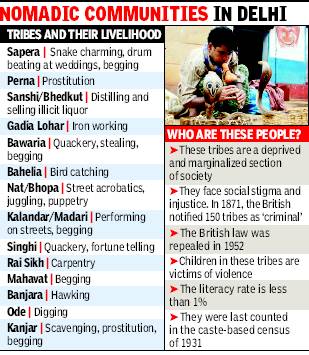Delhi: tribes
This is a collection of articles archived for the excellence of their content. Readers will be able to edit existing articles and post new articles directly |
Contents |
Tribal people living in Delhi
Finally, capital wakes up to children of ‘infamous’ tribes
Last Data Recorded In 1931, DCPCR Tries To Create Database
Ambika Pandit TNN
“Denotified tribes” like Sapera and Sansi: Poor and neglected, these people live in makeshift clusters with no definite livelihood. The last data on these tribes was collected in a caste census carried out in 1931.
Some nomadic communities living in Delhi
The capital, surprisingly, has numerous nomadic communities—Bawaria, Sansi, Bhedkut, Gadia Lohar, Banjara, Rai Sikh, Sapera, Singhi, Bahelia, Kalander, Nat, Kanjar, Ode and Perna.
Ramesh Rahi from All India Sahasmal Bhantu Samaj Sangh said about two lakh Sansis live in Delhi. “Many are engaged in sale of illicit liquor. Those who want to give it up are forced to do the same work,” he alleged. J R Sharan, managing trustee of Sankalp Foundation, which rescues and rehabilitates sex workers, said the Bedias push their girls into sex work at G B Road brothels as prostitution has been a traditional livelihood for them.
Criminal Tribes Act
The tribes are still suffering the effects of an 1871 British law-—Criminal Tribes Act—that declared about 150 of them ‘criminal’ and gave police wide powers to arrest them and monitor their movements.
“Just being born into one of those 150 tribes made a person a criminal. The government of India repealed this draconian act in 1952 but their case has not received sufficient attention from democratic polity and civil society. Their closed, inward looking cultures have also been an obstacle in the way of change and development,” Ramesh said, adding that the children of these tribes are influenced by their environment of “uncertainty, insecurity, polygamy and physical violence”.
Where they live
Such stories of neglect and poverty abound in Rangpuri Pahari and Mahipalpur also that have concentrations of Sapera (snake charmers) and Singhi (quacks) communities. Nats, who make clay toys, beat drums and beg for a living, are concentrated in northeast Delhi’s Ekta Vihar, Sonia Vihar and Rajeev Gandhi Camp.
Kalanders live in Kalander Colony near Dilshad Garden. With street shows using monkeys and bears banned, they are reduced to street performers and magicians, and even resort to begging.
